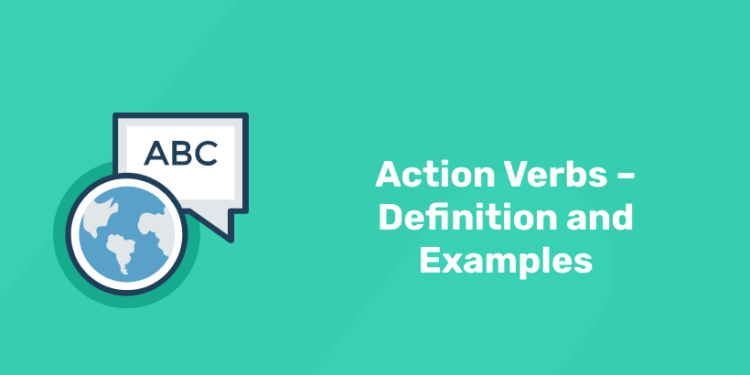Table of Contents
Action verbs or dynamic verbs, are verbs that express an action that a person, animal, or thing can perform. They describe the physical or mental actions of a subject. It can be used to show movement, sound, touch, taste, and feelings. Action verbs are used in sentences to make the meaning more clear and descriptive. They play a critical role in communicating action and movement. Examples of action verbs include run, jump, swim, dance, laugh, cry, sing, speak, and think. In this article we shall discuss Action Verbs – Definition and Examples.
Learn Spoken English with Expert Mentors! Enroll Here!
Action Verbs – Definition and Examples
An action verb or a dynamic verb, is a type of verb that expresses an action that a subject can perform. These verbs describe physical or mental actions. They play a critical role in communicating movement, activity, and intention in a sentence.
Action verbs are essential for describing actions that a person, animal, or thing can do. They convey the meaning of the sentence and make it more descriptive and engaging.
Definition of Action Verb
Action verbs, also known as dynamic verbs, are verbs that describe a physical or mental action that a subject can perform. They indicate what the subject is doing, has done, or will do. Action verbs can be used to show movement, sound, touch, taste, and feelings.
Examples of action Verbs
Here are some examples of action verbs used in sentences:
- The dog barks at the mailman every day.
- She runs five miles every morning to stay in shape.
- The children play in the park on Saturdays.
- He builds model airplanes as a hobby.
- They swim in the lake during the summer.
- She writes in her journal every night before bed.
- He plays the guitar for his friends and family.
- The chef cooks a delicious meal for the guests.
- The birds sing sweetly in the morning.
- She dances gracefully across the stage.
These sentences use action verbs to describe physical or mental actions that the subject is performing. By using action verbs, the sentences become more descriptive and engaging. This allows the reader to visualize the action and understand the meaning more clearly.
Need for Action Verbs
Action verbs are an essential component of language because they help to convey meaning and provide context to sentences. Here are some reasons why action verbs are important:
They communicate action:
Action verbs indicate what a subject is doing, has done, or will do. They help to show the action or movement taking place. They can help to paint a picture in the reader or listener’s mind.
They add detail:
Action verbs add detail to sentences and help create a more vivid and engaging picture of the action taking place. Without action verbs, sentences may be vague and lack detail.
They improve clarity:
Using action verbs can make sentences more clear and easy to understand. They help to communicate the message more effectively and can help to avoid confusion or ambiguity.
They create interest:
Action verbs can make writing more interesting and engaging to the reader. They help to create a sense of excitement and movement, which can keep the reader engaged.
Overall, action verbs are a critical component of effective communication. They help to convey meaning, add detail, improve clarity, and create interest. Using action verbs can make writing more effective, engaging, and memorable.
Most Commonly Used Action Verbs
Here are some of the most commonly used action verbs in English:
| Common Action Verbs | |||
| Run | Dance | Drink | Talk |
| Walk | Sing | Write | Listen |
| Jump | Play | Think | Fly |
| Swim | eat | Speak | Drive |
| Work | Sleep | Study | Read |
These are just a few examples of the many action verbs in English. Other common action verbs include “run,” “climb,” “laugh,” “cry,” “draw,” “paint,” “cook,” “clean,” “wash,” and “exercise.” Action verbs are an essential part of the English language. They are used to describe a wide range of actions, movements, and activities.
Learn Spoken English with Expert Mentors! Enroll Here!
Classification of Action Verbs
Action verbs can be classified in different ways, based on their properties and characteristics. Here are some common classifications of action verbs:
Transitive and Intransitive Verbs:
Transitive verbs are those that take an object in the sentence, which is the receiver of the action. For example, “I eat an apple” – the verb “eat” is transitive, and the object is “an apple.” Intransitive verbs, on the other hand, do not take an object in the sentence. For example, “I run in the park” – the verb “run” is intransitive and does not require an object.
Regular and Irregular Verbs:
Regular verbs follow a pattern when forming the past tense (adding “-ed”). Irregular verbs have unique past tense forms that do not follow a pattern. For example, the regular verb “walk” becomes “walked” in the past tense. On the other hand the irregular verb “go” becomes “went” in the past tense.
Stative Verbs and Dynamic Verbs:
Stative verbs are verbs that describe a state or condition, rather than an action or movement. Examples include “know,” “believe,” “love,” “hate,” “understand,” and “remember.” Dynamic verbs, on the other hand, describe physical or mental actions and movements. Examples include “run,” “dance,” “sing,” “write,” and “think.”
Auxiliary Verbs:
Auxiliary verbs are used to form tenses, moods, and voices, and to add emphasis to a sentence. Examples of auxiliary verbs include “be,” “have,” and “do.” They can be used with other verbs to form verb phrases, such as “I am eating” or “She has written a book.”
Phrasal Verbs:
Phrasal verbs consist of a verb and one or more particles (such as prepositions or adverbs). They have a meaning that is often different from the individual words. Examples include “take off,” “turn up,” “give in,” and “look after.”
Conclusion
Action verbs are a fundamental part of the English language, as they are used to describe actions, movements, and activities. They are often the main focus of a sentence and can be used in various forms. Different forms include transitive or intransitive verbs, regular or irregular verbs, stative or dynamic verbs, auxiliary verbs, and phrasal verbs. Action verbs can be used to add clarity, specificity, and interest to a sentence. Action verbs make it more engaging and effective in communicating information. Overall, understanding the use and function of action verbs is crucial for effective communication in the English language.
Learn Spoken English with Expert Mentors! Enroll Here!
Action Verbs – Definition and Examples: FAQs
1: Which of the sentences below is grammatically correct?
1. What is an action verb?
Ans. An action verb is a verb that describes an action or movement that a person, animal, or object is performing. Examples include “run,” “dance,” “swim,” and “play.”
2. What is the difference between a transitive and intransitive verb?
Ans. A transitive verb is a verb that requires an object to complete its meaning. An intransitive verb does not require an object. For example, “eat” is a transitive verb because it requires an object (e.g. “I eat an apple”).”Run” is an intransitive verb because it does not require an object (e.g. “I run in the park”).
3. What are regular and irregular verbs?
Ans. Regular verbs follow a predictable pattern when forming their past tense (by adding “-ed” to the base form). Irregular verbs on the other hand have unique past tense forms that do not follow a predictable pattern. For example, “walk” is a regular verb (“I walked”), while “go” is an irregular verb (“I went”).
4. What are stative and dynamic verbs?
Ans. Stative verbs describe a state or condition, while dynamic verbs describe an action or movement. Examples of stative verbs include “know,” “love,” and “remember”. Examples of dynamic verbs include “run,” “dance,” and “play.”
5. What are auxiliary verbs?
Ans. Auxiliary verbs are used to form tenses, moods, and voices, and to add emphasis to a sentence. Examples of auxiliary verbs include “be,” “have,” and “do.”
6. What are phrasal verbs?
Ans. Phrasal verbs consist of a verb and one or more particles (such as prepositions or adverbs) and have a meaning that is often different from the individual words. Examples include “take off,” “turn up,” “give in,” and “look after.”
7. Why are action verbs important?
Ans. Action verbs are important because they provide clarity and specificity to a sentence. Action verbs help the reader or listener to understand the action or movement being described. They also make the sentence more interesting and engaging. This can help to hold the reader’s or listener’s attention.











